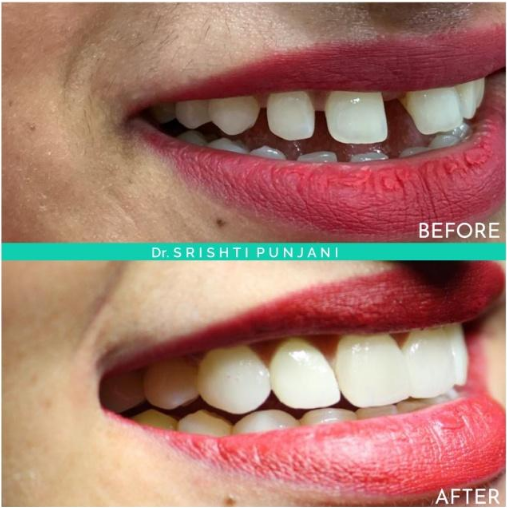Everything You Need to Know About Tooth Gaps Filling in Delhi
Are you concerned about the cost of teeth gap filling in Delhi? Do you want to understand the reasons behind tooth gaps and explore the treatment options available in the capital? This comprehensive guide will walk you through everything you need to know about tooth gap filling in Delhi, from causes to costs and treatment methods.

Understanding Tooth Gaps
What Are Tooth Gaps?
Tooth gaps, medically referred to as diastema, are spaces between teeth. These gaps can occur anywhere in the mouth but are most commonly noticed between the upper front teeth. While some people might embrace their tooth gaps as a unique characteristic, others might seek ways to close these spaces for aesthetic or functional reasons.
Why Do You Have Tooth Gaps?
Tooth gaps can result from various factors. Here’s a closer look at some common causes:
1. Genetic Factors
Your genes play a significant role in the development of tooth gaps. If your family members have tooth gaps, you are more likely to have them too. This could be due to inherited jaw size or tooth size discrepancies.
2. Jaw and Tooth Size Discrepancies
A mismatch between the size of your jawbone and the size of your teeth can lead to gaps. If your jaw is too large for your teeth, you might notice spaces between them.
3. Habits and Oral Conditions
Certain habits, such as thumb sucking during childhood, can cause teeth to move and create gaps. Additionally, oral conditions like an oversized labial frenum (the tissue that connects the upper lip to the gums) can push teeth apart, resulting in gaps.
4. Improper Alignment
Poor alignment of teeth due to orthodontic issues can cause gaps. When teeth are not properly aligned, spaces can develop between them.
How Can We Treat Your Tooth Gaps?
Orthodontic Treatment
Orthodontic treatments, such as braces or aligners, are a common method for closing tooth gaps. These treatments gradually shift teeth into their correct positions over time. While effective, orthodontic treatment can be time-consuming and, in some cases, gaps may reappear after treatment.
Dental Bonding
Dental bonding is a popular and non-invasive option for filling minor tooth gaps. During this procedure, a tooth-colored resin (composite) is applied to the surface of the teeth and shaped to fill the gaps. This method is quick and cost-effective, making it a preferred choice for many.
Veneers
1. Composite Veneers
Composite veneers, also known as componeers, involve applying a composite material to the teeth to close gaps. This method is minimally invasive and suitable for minor gaps.
2. Porcelain Veneers
Porcelain veneers are thin shells of porcelain custom-made to fit over the teeth. They are a more durable and aesthetic option compared to composite veneers. Porcelain veneers are ideal for closing larger gaps and improving the overall appearance of teeth.
The Procedure for Closing Tooth Gaps
Consultation and Planning
The first step in any tooth gap treatment is a consultation with a dentist. During this visit, the dentist will discuss your goals and examine your teeth to determine the best treatment plan.
Smile Design
For treatments like veneers, smile design is an essential step. The dentist will take pictures of your teeth and consider factors such as your face shape, skin tone, and lip structure to design a smile that complements your overall appearance.
Tooth Preparation
For dental bonding and veneers, the next step involves preparing the teeth. In the case of bonding, the tooth surface is etched to ensure the composite adheres properly. For veneers, a small amount of enamel is removed to make room for the veneers.
Application and Bonding
1. Dental Bonding
The composite resin is applied to the prepared tooth, shaped to fill the gap, and hardened using a special light. The dentist then polishes the resin to match the surrounding teeth.
2. Porcelain Veneers
Impressions of your teeth are taken and sent to a dental lab where custom veneers are made. Once the veneers are ready, they are tried on and bonded to your teeth using dental cement.
Cost of Gap Filling in Delhi
The cost of tooth gap filling in Delhi varies based on the treatment method and the complexity of the case. Here is a breakdown of the costs:
Orthodontic Treatment
Orthodontic treatments like braces or aligners can cost between INR 50,000 to INR 2,00,000 or more, depending on the duration and complexity of the treatment.
Dental Bonding
Dental bonding is more affordable, with costs ranging from INR 8,000 per tooth.
Porcelain Veneers
Porcelain veneers are the most expensive option, costing between INR 15,000 to INR 20,000 per tooth or more.
Advantages and Disadvantages of Different Treatments
Orthodontic Treatment
Advantages
- Effective for large gaps and complex alignment issues
- Long-lasting results
Disadvantages
- Time-consuming (may take months to years)
- Can be expensive
- Risk of gaps reappearing after treatment
Dental Bonding
Advantages
- Quick and affordable
- Minimally invasive
Disadvantages
- Suitable for minor gaps only
- Composite resin may stain over time
- Less durable than veneers
Porcelain Veneers
Advantages
- Highly aesthetic and durable
- Suitable for large gaps
- Custom-made to match your smile
Disadvantages
- Expensive
- Requires enamel removal
- Irreversible
Choosing the Right Dentist in Delhi
When considering tooth gap treatment, choosing the right dentist is crucial. Here are some tips for finding a reputable dentist in Delhi:
Research and Recommendations
Start by researching dentists who specialize in cosmetic dentistry or orthodontics. Ask for recommendations from friends, family, or online reviews.
Check Credentials
Ensure the dentist has the necessary qualifications and experience in performing the specific treatment you need.
Consultation
Schedule a consultation to discuss your concerns and treatment options. A good dentist will listen to your needs and provide a detailed treatment plan.

